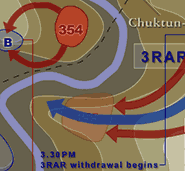The Korean War
It was the first major war of a larger conflict, the Cold War. The Cold War was a political, economic and military contest between the two post-war superpowers, the United States of America and the Union of Soviet Socialist Republics (Soviet Union). The Republic of Korea (south) was supported by the United States which persuaded the United Nations to side with her. Australia was one of the 21 members of the United Nations which sent military forces to aid the south. The Democratic People’s Republic of Korea (north), was backed by China and the Soviet Union.

United Nations Korea Medal, with ribbon. As issued to US servicemen and women. [AWM REL25156.034] ... Enlarge the image of the medal
The war began on 25 June 1950 when North Korea invaded South Korea. The superior North Korean forces were on the verge of conquering all of South Korea when United Nations forces intervened. Among the first was 77 Squadron of the Royal Australian Air Force and HMAS Shoalhaven and Bataan of the Royal Australian Navy. A United Nations counteroffensive defeated the North Korean army and pursued it into North Korea. When the United Nations forces approached the border between Korea and China the Chinese entered the war in support of North Korea. The now outnumbered United Nation forces were pushed south and the capital Seoul once again fell to the communists.
In early 1951 the United Nations again advanced, securing a line just beyond the 38th parallel of latitude - the dividing line between north and south before the war. It was in this phase of the war that 94 Australians of 3rd Battalion Royal Australian Regiment were killed, wounded or captured at the Battle of Kapyong.
After a year of mobile warfare, in which Seoul changed hands four times, the front line stabilised and peace negotiations began. The remaining two years of fighting bore the character of World War I trench warfare, except that the trenches were in the cold and inhospitable mountains of Korea. Patrols and ambushes in no-man’s-land were continuous and both sides staged occasional large offensives to influence the peace negotiations.

Injured Australian soldier Bomber Brown. [AWM PO 147334] ... Enlarge the photograph of the injured soldier
On 27 July 1953 a ceasefire was agreed to but negotiations for a formal peace agreement were never concluded. North and South Korea today remain technically still at war and the ceasefire line – the frontline when fighting stopped – is closely guarded by armies on both sides.
During the war over half a million military personnel and more than one million civilians died. Half of Korea’s industry and a third of all housing were destroyed.
Some 17,000 Australians fought in Korea; 340 Australians died there.























